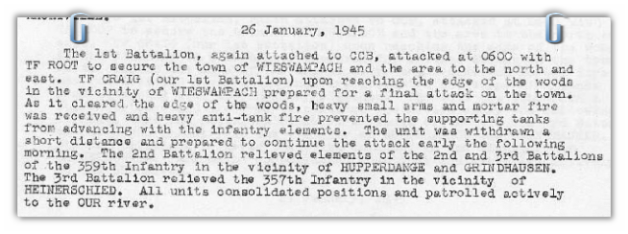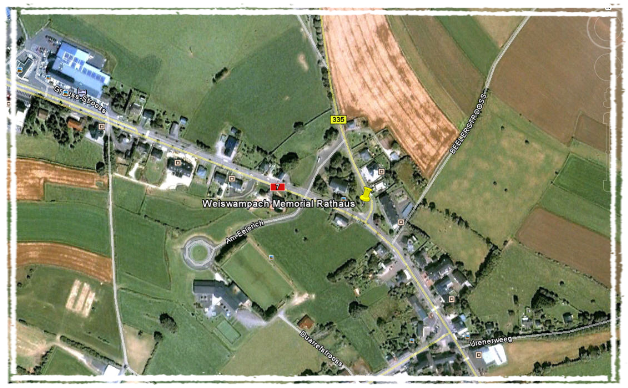Memorial am Rathaus Weiswampach - WW1 World War Tours WW2
Hauptmenü:
- Startseite
- Einleitung
- Steckbrief - über mich
- privater Hintergrund
- Grabpatenschaften
- geschicht. Hintergrund
-
Heimatgeschichte
- Geschichte von Eupen in Stichworten
- Kanton Eupen-Malmedy
- Eupen Mai 1940
- Heimattreue Front
- Blutzeuge Joseph Kerres
- Eupen Mai 1945
- Armée Blanche
- Kriegszeppeline überfahren Eupen
- Graf Zeppelin auf Stippvisite
- Demarcation stone WWII Hütte
- Memorial 1. US-Infantry Division Klötzerbahn
- Gedenkstein Opfer Naziregime
- Kaplan Jean Arnolds
- Patriotin Maria Kreuels
- Ehrenfriedhof Eupen
- Pfad der Erinnerung
- Bunker Eupen Unterstadt
- Kriegerdenkmal Werthplatz
- Kneipp Kurhaus
- Kriegswahrzeichen Eupen Friedenspark
-
Ardennenoffensive
- Ardennenoffensive
- Unternehmen Greif
- Unternehmen Stösser
- Unternehmen Bodenplatte
- Schlacht um Lanzerath
- Honsfeld Kriegsereignisse
- Schlacht um St. Vith
- Elsenborn Ridge
- Camp Elsenborn
- Massaker von Baugnez
-
Festungsanlagen
-
Belgien
- Festungsring Lüttich
- Fort Aubin-Neufchâteau
- Fort de Tancrémont
- Fort Battice
-
Fort Eben-Emael
- Fort Eben-Emael
- Sturm auf das Fort Eben-Emael
- Eben-Emael 29.09.2018
- Bildergalerie Fort Eben-Emael
- Videos Fort Eben-Emael
-
Frankreich
- Fort Hackenberg (F)
-
Belgien
-
WWI Battlefields
- Ypern - Ieper
- Ehrenfriedhöfe
- Memorial St. Julien
- Bunker bei Langemark
- Besucherzentrum Tyne Cot
- Site John McCRae
- In Flanders Fields
-
Gedenkstätten Mahnmale
-
Belgien
-
Gedenkstätten Orte A-D
- Aubel
- Aubin-Neufchâteau
- Baelen
- Bastogne
- Battice
- Baugnez
- Bilstain
- Bleyberg / Gemmenich
- Botrange Signal
- Büllingen
- Bütgenbach
- Bütgenbach/Büllingen
- Dolhain
- De Panne
-
Gedenkstätten Orte E-K
- Eben-Emael
- Elsenborn
-
Elsenborn Camp
- Memorial Demineurs
- Memorial all american soldiers
- Eupen
- Grand-Halleux
- Grandménil
- Henri-Chapelle
- Honsfeld
- Jalhay
- Kelmis
- Kotem
-
Gedenkstätten Orte L-N
- La Gleize
- Langemark-Poelkapelle
- Lanzerath
- Ligneuville
- Lontzen
- Losheimer Graben
- Malmedy
- Medell - Amel
- Meyerode
- Mons
- Montzen
- Montzen Gare
- Moresnet
- Neufchâteau
-
Gedenkstätten Orte O-U
- Remersdael
- Rocherath Krinkelt
- Sourbrodt
- Sourbrodt - 158 Squadron
- Stavelot
- St. Vith
- Tancrémont
- Thimister-Clermont
- Trois-Ponts
-
Gedenkstätten Orte V-Z
- Vielsalm
- Wanne
- Wereth
- Wereth Familie Langer
- Wirtzfeld
-
Gedenkstätten Orte A-D
-
Deutschland
- Aachen
- Dachau (KZ)
- Hattenheim
- Hellenthal
- Hürtgen
- Imgenbroich
- München
- Mützenich
- Peterberg Ochsenkopf
- Simonskall
- Vossenack
- Würselen
- Frankreich
- Luxemburg
-
Niederlande/Holland
- Nijswiller
- Bruinisse
- Simpelveld
- Wissenkerke
- Wijnandsrade
-
Belgien
-
Kriegerdenkmäler
- Vorwort und Einführung
-
Kriegerdenkmäler Orte A-G
- Aubel
- Bilstain
- Bütgenbach
- Cherain
- Clermont
- Elsenborn
- Eupen
- Eynatten
- Galhausen
-
Kriegerdenkmäler Orte H-N
- Hauset
- Henri-Chapelle
- Heppenbach
- Honsfeld
- Kelmis
- Kettenis
- La Gleize
- Lommersweiler
- Lontzen
- Medell
- Meyerode
- Moresnet
- Neundorf
- Nidrum
-
Kriegerdenkmäler Orte O-U
- Pepinster
- Recht
- Thimister
- Kriegerdenkmäler Orte V-Z
-
Museen
-
Belgien
- Aubin-Neufchâteau
- Bastogne Ardennes 44 Museum
- Bastogne Barracks
- Baugnez´44 Center
- Elsenborn
- Ensival
- La Gleize Neugestaltung
- La Gleize
- Lontzen Dorfhaus
- Passendale
- Thimister-Clermont
- Ypern
- Niederlande
-
Belgien
-
Ehrenfriedhöfe
-
Belgien
- Bard Cottage
- Brielen/Ypern
- Eupen
- Henri-Chapelle
- Langemark
- Malmedy
- Neufchâteau
- Neuville-en-Condroz
- Nidrum
- Passendale
- Wanne
-
Deutschland
- Hürtgen (D)
- München (D)
- Vossenack
- Vossenack 2016
-
Luxemburg/Luxembourg
- Sandweiler (L)
-
Belgien
- Westwall
-
Remembrance/im Gedenken
- Vorwort
- RYAN William Bill CSM
- Personen A-E
- Personen F-J
- Personen K-O
- Personen P-T
- Personen U-Z
-
Videoecke
-
Jahr 2017
- Manhay Ardennes History
-
Jahr 2016
- The Final Thrust Eupen
- Operation Spring Awakening
-
Jahr 2015
- Reenactment Bastogne Area
- Reenactment Fort Eben Emael
-
Jahr 2014
- Bastogne NUTS 2014
- Grave Adoption Ceremony 18.09.2014
- Bevrijdingsfeest Noorbeek
- Simpelveld Weekend at War
- Kelmis Gedenkfeier 30.08.2014
- Veteran F. Haugustaine
- Pfc. Robert CAHOW Commemoration
- Memorial Day Henri-Chapelle
- Hammerbrücke 11.05.2014
- Montzen Gare Bombardierung
- Jahr 2013
-
Jahr 2012
- Wereth Gedenkfeier 2012
- TOP HAT 2012
- Aubin M46 Kampfpanzer
- Ride 2 Recovery 2012
- Aubin Neufchâteau 2012
- Memorial Day 2012 Henri-Chapelle
-
Jahr 2011
- Historical Reenactment Baugnez 2011
- Wereth Eleven Gedenkfeier 2011
- Parrainage Tombe Henri-Chapelle 2011
- Ardennes American Cemetery and Memorial 2011
- Memorial Day 2011 Henri-Chapelle
- Fort Aubin Neufchâteau Portes ouvertes 2011
- Wereth 11 Eleven 2011
-
Jahr 2010
- Soldatenfriedhof Hürtgen 2010
- Ehrenfriedhof Vossenack 2010
- Ehrenfriedhof Sandweiler 2010
- Memorial Day 2010 Henri-Chapelle
- Videos Fort Tancrémont 2010
- Videos Fort Battice 2010
- Jahr 2009
- Jahr 2007
-
Jahr 2017
-
entlang des Weges
-
diverse POIs A-F
- Aachen
- Bastogne
- Battice Bunker beim Fort
- Bütgenbach
- Courtil
- Elsenborn
- Eupen Bunker Kabelwerk
- Fuerteventura
- Eupen Spitzberg
-
diverse POIs G-N
- Gouvy
- Henri-Chapelle
- Hombourg Abri G
- Imgenbroich
- Langemark
- Monschau
- Neufchâteau
- Halconreux
-
diverse POIs O-Z
- Sippenaeken/Teuven
- St. Vith
- Vielsalm
- Walheim
-
diverse POIs A-F
-
Fahrzeuge/Material als Mahnmale
-
Belgien
- Aubin Neufchateau
- Bastogne
- Cherain
- Eben Emael
- Kotem
- La Gleize
- Manhay Grandmenil
- Meyerode
- Stavelot
- Thimister Clermont
- Vielsalm
-
Frankreich
- Kientzheim
- Veckring
-
Kanada
- Vancouver
-
Belgien
-
Waffentechnik
- Infanterie
- Artillerie
- ungepanzerte Fahrzeuge
- gepanzerte Fahrzeuge
- Spezialwaffen
- Flugzeuge
-
GRENZECHO Tageszeitung
- Vorwort Einführung der Rubrik
- Geschichte des GRENZECHO
-
Artikel von Interesse
- Jahr 2017
-
Jahr 2016
- Weihnachten an der Front
- Grenzland in Flammen
- Gedenkfeier St. Vith
- Gedenkfeier Roderhöhe
- Kriegsgräberstätte Vladslo
- The Final Thrust @Eupen
- US Veteran Merritt
- ZVS-Museum
- Gedenkfeier Kusy Denkmal
- Dorfplatz Raeren Kriegerdenkmal
- NS-Ordensburg Vogelsang
- als der Kaiser uns rief
- Wereth Eleven Gedenkfeier
- US Veteran Juan Mejia
- Gräber Adoptionsprogramm
- Schlacht um Verdun
- Hölle Verdun
- Leopold II
-
Jahr 2015
- Adolf Hitler Skisprungschanze
- Geschichte Lager Elsenborn
- Gedenkfeier Roder Höhe
- Felsenkeller Kelmis
- Infotafeln Rocherath
- Museum Joubieval
- Stolpersteine Ramscheid
- George Ciampa Zeitzeugenaufruf
- Rückführung Crew Hunconscious
- Gedenkfeier Memorial KUSY
- Buch Battaille des Ardennes M. Billa
- Manifest von Botrange Buch
- Gedenkfeier Wereth Eleven
- Huppermans Willy Kelmis
- Kriegsgräber Nidrum
- Kriegserholungsheim Kehrberg
- Einheimische Nazis
- Kriegsende 1945 Stunde Null
- Wilhelm Langer Recherchen
- Genickschuss oder Heimkehr
- Giftgasangriffe Erster Weltkrieg
- Weg des Gedenkens
- Gedenktourismus boomt
- Mythos Bismarck
- Buchvorstellung Henri Michel
- Henri Michel Chefredakteur GE
- Ausstellung ZVS Erster Weltkrieg
- neue Gedenktafel 82nd Airborne Lanzerath
- Hölle von Auschwitz
- Todeslager Auschwitz
- Ausstellung Routes of Liberation
-
Jahr 2014
- Apokalypse Ardennen
- Aachen
- St. Vith
- Kriegserfahrungen
- Heck Karl-Heinz
- Roderhöhe
- Domäne Bütgenbach
- Tour Tagung WW1
- Kriegserfahrungen Ausstellung
- Rexismus in Belgien
- Bahnhof Herbesthal
- Gedenktafel Kelmis
- Webseite Kriegserfahrungen
- Gedenkfeier Malmedy
- Eupener Kriegerdenkmal
- Gedenkfeier Yser
- Buch Gäste des Führers
- ZVS Rundfahrten
- Dr. Herbert Ruland
- Ausstellung Welkenraedt Charles Dekeyser
- Kriegserfahrungen
- Patenschaftsfeier Henri-Chapelle
- Kreisverkehr Neutralstrasse
- Offene Denkmäler
- Emmels Ausstellung
- Einmarsch in Baelen
- Prominenz in Cointe
- Hand zur Versöhnung
- Gedenkfeier Herbesthaler Bahnhof
- im Dienste des Teufels
- Cointe Lüttich
- Gedenken Normandie
- Happy D-Day
- Schmitz Peter Golgatha
- Gedenktafel Botrange
- Wereth Gedenkfeier
- Mardasson Memorial Bastogne
- Gedenkfeier Hammerbrücke
- Aktionstage politische Bildung
- Gedenkfeier in Wereth
- Bombenfund Bütgenbach
- Geschichtsverein ZVS
- Bastogne War Museum
- Armeemuseum Ausstellung
- Munitionssprengung Elsenborn
- KIA Glenn Ward
- Vier Grenzen Land
- Spuren Erster Weltkrieg
- Westwall Stiftung
- Malmedy Erster Weltkrieg
- Verkauf Musikbunker Aachen
- Anton Schmitz Eupen
-
100 Jahre Erster Weltkrieg
- Märtyrerstadt Dinant
- Einmarsch Francorchamps
- Massaker von Dinant
- Gedenkfeier in Cointe WW1
- Historische Versöhnung
- Lüttich wieder eine Festung
- Heldentat des Antoine Fonck
- Strafgericht über Löwen
- von Ypern bis Syrien
- Ausstellung Grenzregion
- Lothringen vergessene Schlacht
- Erste Schüsse erste Tote
- Belgiens Eisenbahn WW1
- Attentat auf Hitler
- Osmanisches Reich
- Freilichtmuseum Mechernich
- preussische Wallonie
- 100 Jahre Erster Weltkrieg
- Machtgefüge WW1
- Grenzbahnhof Herbesthal
- Deutsche Kriegsverbrechen
- Projekt Traces1914
- Ypern Erster Weltkrieg
- Ausstellung Zitadelle Dinant
- Gedenken in Verdun
- Antwerpen uneinnehmbare Stadt
- Abteil Stavelot Ausstellung
- Grande guerre Frankreich
- USA Erster Weltkrieg
- Schuld am Ersten Weltkrieg
- Brüsseler Expo 14-18
- Töten im industr. Massstab
- Ausstellung 14-18
- Belgiens Sonderrolle
- Leo Kever Leben im WW1
-
Jahr 2013
- US Veteran Sheaner
- Bild des Königshauses
- Verlegung Stolpersteine
- Leo Kever Eupen
- Projekt EUROPEANA
- Kriegerdenkmal Hauset
- erste Stolpersteine DG
- Reederei Red Star Line
- französische Invasion
- Projekt virtuelles Museum
- Camp Elsenborn
- Lousbergbunker Aachen
- Eynattener Kriegerkapelle
- Eisenbahnbrücke Bildchen
- Gare revit Herbesthal
- Waggons Erster Weltkrieg
- Gedenkstätten Erster Weltkrieg
- Museum La Gleize
- Kriegerdenkmal St. Vith
- Bomber Ärmelkanal
- Feierlichkeiten Erster Weltkrieg
- Leon Schillings Eupen
- 70 Jahre Dusenflugzeug
- Gedenkfeier Hammerbrücke
- Erinnerungsjahre DG
- Bücherverbrennungen
- Einweihung Orientierungstafeln Fort Aubin
- Gedenken an den Ersten Weltkrieg
- Warschauer Ghetto
- Konzentrationslager Dachau
- Stolpersteine dezentrales Denkmal
- In Flanders Fields
- Zwangssoldaten Ostbelgien
- Geschwister Scholl
- Stalingrad
- Zeitzeuge Max Mannheimer
- Instandsetzung Denkmal Werthplatz
- Friedensmahnmal Westwall
-
Jahr 2012
- Museum Kazerne Dossin
- NS-Dokumentation Vogelsang
- Kaplan Jean Arnolds
- Grabungen Raeren Me210
- IRMEP Kommandantenwechsel
- Wereth Gedenkfeier 2012
- Panzerlieferung Fort Aubin-Neufchâteau
- Heimattreue Front
- Absturz der Hunconscious in Allmuthen
- Wallenberg Raoul
- Lommel letzte Ruhestätte
- Pionier Peter Becker
- Memorial Day 26.05.2012 Henri-Chapelle
- Stolpersteine GrenzGeschichte DG
- Grenzstein Nr.187 am weissen Haus
-
Jahr 2011
- RE-ENACTMENT Baugnez G.B.R.H.M. 40/45 club
- Living History Group auf den Spuren der 2. US Infantry Division
- Ausstellung im Malmundarium
- Eupen Military Vehicule Friends Bastogne NUTS 2011
- abgestürzter Pilot in Raeren
- US-Veteran Seymour »Sy« Reitman
- US-Veteran James Fort Jr.
- 2nd. Ltn. Hilding Johnson
- Film The Wereth Eleven
- Jahr 2010
- über meine Webseite Person
-
Erkundungstouren Berichterstattungen
- Jahr 2012
- Jahr 2011
- Jahr 2010
-
Jahr 2009
- Memorial Ceremony Massacre Baugnez 2009
- Vielsalm to Bastogne
- kleine Eifeltour (B)
- Tanks in Town 2009
- Remember Museum 39-45
- Fort Tancrémont 2009
- Aubin-Neufchâteau 2009
- Westwallführung 2007
- Jahr 2004
- Karikaturen
- Literatur/Medien
- Abkürzungen
- Kurioses
- Download GPS-Daten
- meine Favoritenlinks
- Kontakt
- Gästebuch
- Datenschutzerklärung
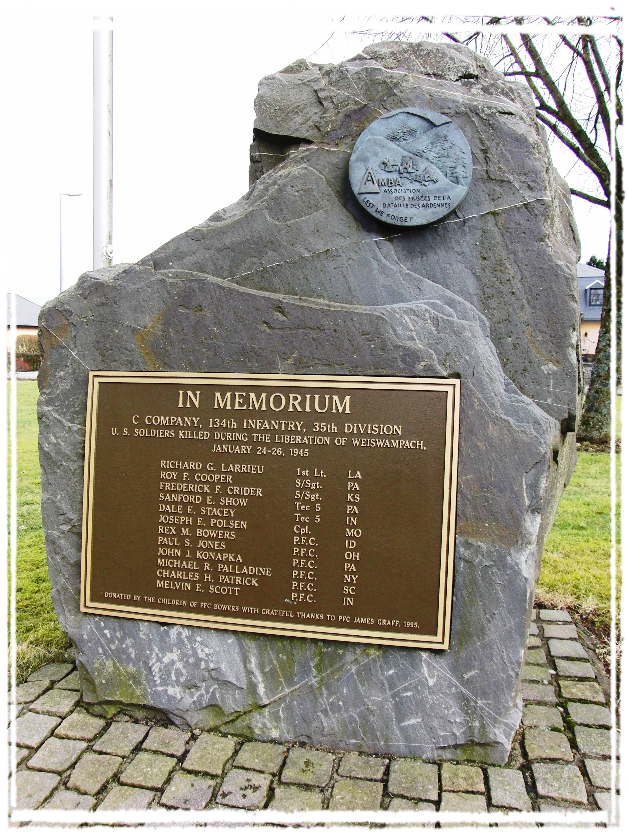
Das Denkmal für die "C" Company, 134th Infantry, 35th Division befindet sich in unmittlebarer Nähe zum Gebäude der Stadtverwaltung bzw. am Rathaus von Weiswampach (L). Dieses Memorial besteht aus einem Gedenkstein mit 2 Tafeln. Die erste Tafel umfasst die Namen der Gefallenen und die zweite Tafel ist von der AMBA - Association des Musées de la Bataille des Ardennes. Neben dem Gedenkstein wehen die amerikanische und die luxemburgische Fahne.
Der Gedenkstein wurde anlässlich des 50ten Jahrestags der Befreiung von Weiswampach durch die Amerikaner – Ende Januar 1945 – am 1. April 1995 eingeweiht. Am 16.Dezember 2005 wurde von der AMBA die o.g. Plakette zum 60ten Jahrestag des Beginns der Ardenneoffensive auf dem Stein angebracht.
Die Gedenktafel umfasst die Namen der 12 US-Soldaten, die bei der Befreiung des Ortes Weiswampach in der Zeit vom 24. bis 26. Januar 1945 gefallenen sind. Der Tafel ist zudem zu entnehmen, dass diese von den Kindern von Pfc. Rex M. BOWERS gestiftet wurde. Es handelt sich hierbei um David und Marilyn JENSEN. Der Fels, die Fahnemaste usw. wurden von den Bürgern gestiftet. Zudem wird ein besonderer Dank an Pfc. James GRAFF ausgesprochen.
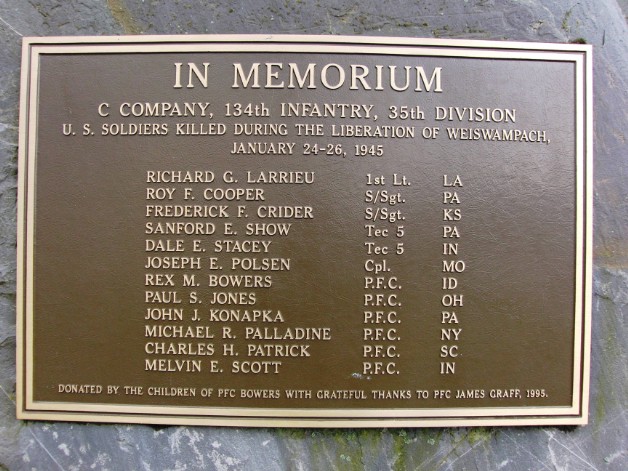
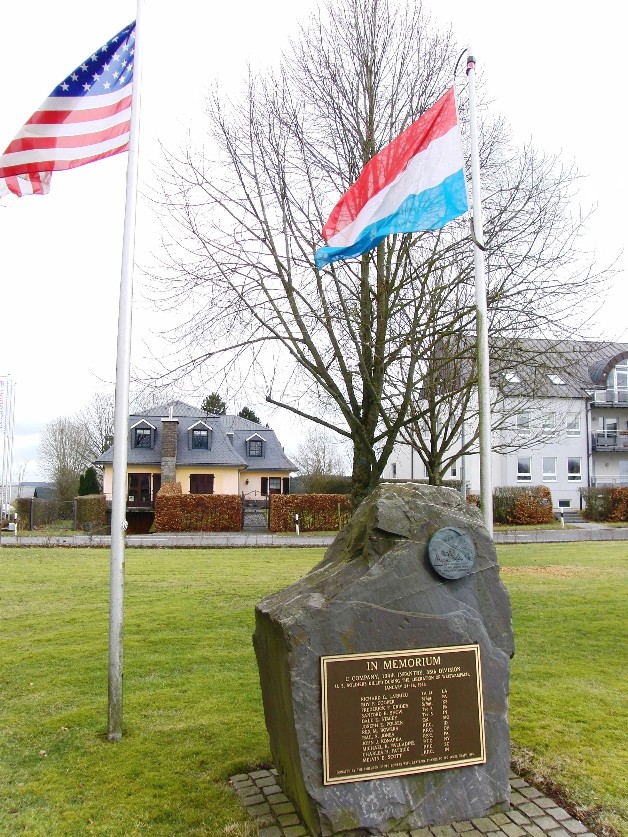
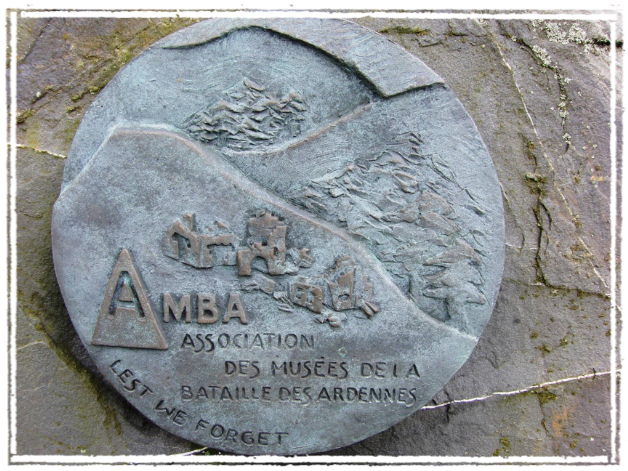
Standortermittlung über Google Earth: DOWNLOAD der kmz-Datei
50 YEARS REMEMBERED
Over 50 years ago, January 24 - 26, 1945 to be exact, was fought a bitter battle at the approaches to and at the small Luxembourg village of Weiswampach. Task Force Craig consisting of the 1st Battalion, 134th Infantry, 35th Division and supported by tanks of the 6th Armored Division to which the 134th had been attached. This was the attacking force.
In C Company, 1st Battalion, 134th was a young infantryman, 25 years old from Idaho: Rex M. Bowers who was a father of three small children. He had joined C Company on January 8, 1945 after leaving the States on December 22, 1944. Rex was trained at Camp Hood, Texas for 17 weeks and after a ten day delay enroute home was shipped out of Boston, Mass. enroute to the ETO. Landing in Greencock, Scotland on Dec. 29 he went by train to Southhampton and across the channel to land on the beach at LeHavre on New Year's Day, 1945. By 40/8 boxcars to Metz and a 90 mile truck ride to Martelange, Belgium and into the line on Jan. 10 southeast of Bastogne near Lutrebois, Belgium.
The Bulge was fast disappearing, but as we members of C Company would find out, the Germans were still full of fight. When pressed close, they turned and fought like junkyard dogs. As we left the half-tracks which had been furnished by the 6th Armored we saw a group of German POWs and a corpse on a child's sled. Also a wounded tanker with a bandage over his eyes was riding in a jeep with another POW perched on the hood. We were soon moving out north of the village of Wilderdange across snow-swept fields while the tanks stayed on the Sky Line Drive. We came under severe small arms fire and in the process lost some men killed and wounded. By late afternoon we had secured shelter in some woods and were busy digging in. Next day we proceeded to advance towards Weiswampach. At first our only obstacle was the deep snow, two or more feet of it. As we came out of the woods west of the village we were subjected to heavy mortar, small arms and tank fire. Again and again we tried to advance, but were beaten down by vicious machine gun fire.
Sometimes in the afternoon of this, the 25th of January, Pfc. Rex M. Bowers was killed in action. Our company was obliged to dig in and later in the evening to fall back to a little town, which had been cleared earlier by the armor. I and another man slept with and old sheep and a couple of lambs. Next morning we again attacked the town from the east and our only loss was one tank to American mines, which had remained, buried in the snow for 6 weeks since the Bulge had begun on December 16, 1944. We were relieved on the afternoon of 26 January by elements of the 358th Infantry, 90th Division. Germany was a stone's throw away over the Our River. C Company had lost on officer and eleven enlisted men KIA, 21 WIA including 3 seriously wounded and 5 enlisted men who were lost to frostbite. C Company had sustained 199 casualties during the month of January, 1945, including 29 KIA and had received a total of 119 replacements - a sad month to say the least.
Forty-nine years were to pass when I got a telephone call from a lady in Denver, Colorado. She asked me, as the Secretary of the 134th Infantry Association, if I could help her find anyone who might have known her father who had been killed in Luxembourg in 1945. I asked some particulars and discovered she was Rex Bowers' daughter. He and I had joined C Company together although I really didn't know him. After a year of corresponding and attending a 35th Division reunion in Topeka, Kansas, Marilyn and her husband David wanted to erect a memorial to her dad and the rest of the men killed with him. With help from Mr. and Mrs. Camille Kohn and Mrs. Tillie Kimmes, who are leaders of the C.E.B.A. group in Luxembourg and, of course, help from the good citizens of Weiswampach we decided on a memorial plaque. It was cast in California. The C.E.B.A. people contacted the village fathers and they erected a seven-ton stone, mounted the plaque and put up matching flagpoles and an eternal light.
On April 1st, 1995 David and Marilyn Jensen, her sister, Diana Schlund, and my wife Alice and I went to Weiswampach, Luxembourg to dedicate this plaque. We were greeted by a great multitude of citizens of the village and surrounding area - the school children, the fire brigade with their youth auxiliary, municipal band, U.S. Embassy officials, city fathers, the lady mayor, the priest, and a great turnout. Also in attendance was Katie Kremer, a native of Weiswampach, who lived there during the war. She now lives in Calumet City, Illinois and we are fortunate to have made her acquaintance.
We dedicated this memorial to the men killed here, but really to all the men of the 35th killed in 10 months of combat in the ETO. You cannot believe the reception they gave us. After the memorial service in the Village Square, we had a huge reception in a large tent erected for this ceremony. Here we met two men who were 16 year old teens when we attacked the town. They told me that the Germans had 20 tanks in the town, but only enough fuel for 3 to be operational. They were waiting for a resupply from across the Our River during the night. They had pulled out when we attacked on the 26th, except for one disabled tank, which was burning, when we entered the town. They also told of the death of 2 civilian women during the attack. A Mrs. Hoffman also lost her right arm.
The Bowers girls and their brother knew nothing about their father's military history, because of some unusual circumstances. I, James G. Graff, of Middletown, Illinois, was a BAR man and platoon runner during my term of service in C Company, 134th Infantry. I came home from overseas with them and was discharged out of the 5th Division in April 1946. My wife Alice and I farmed for 43 years and have been married for 53. We have 4 children and 11 grandchildren.


